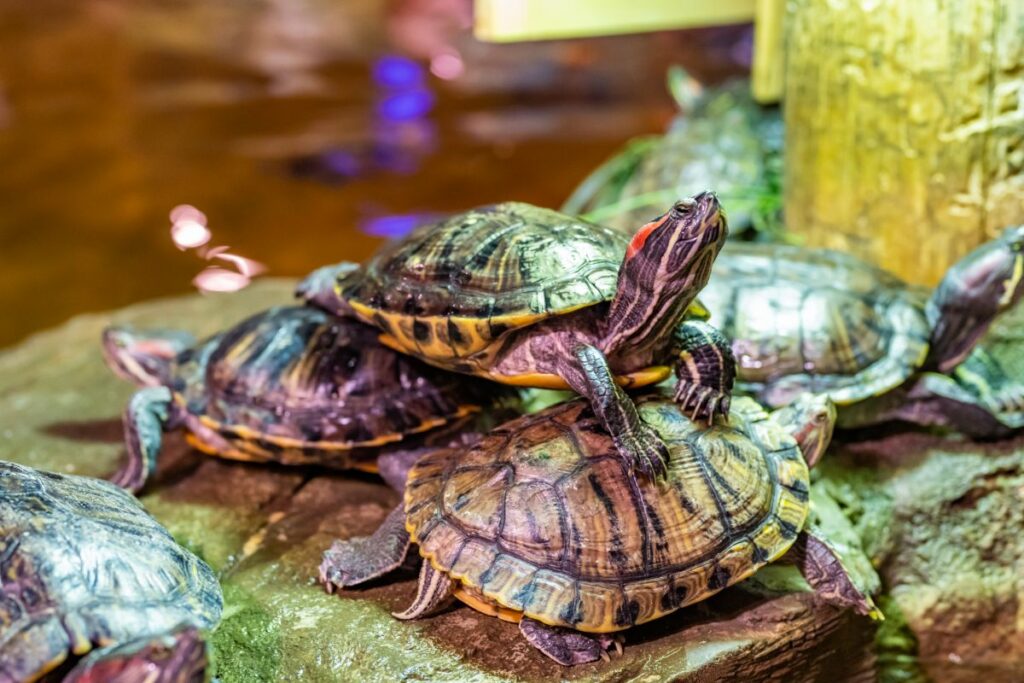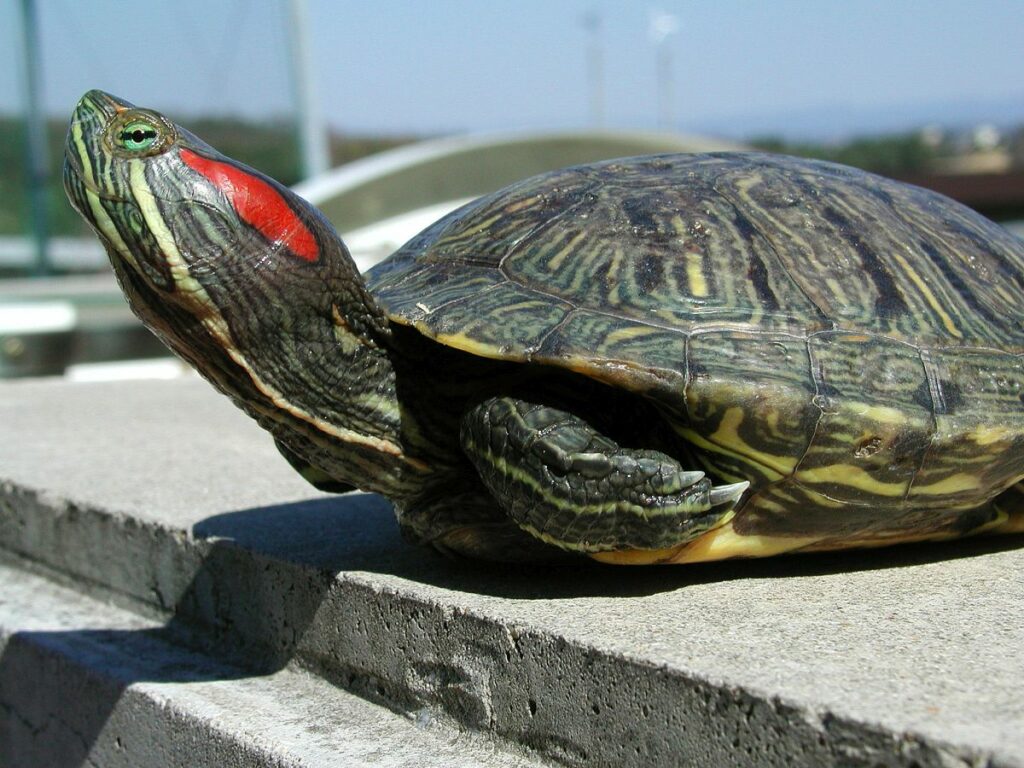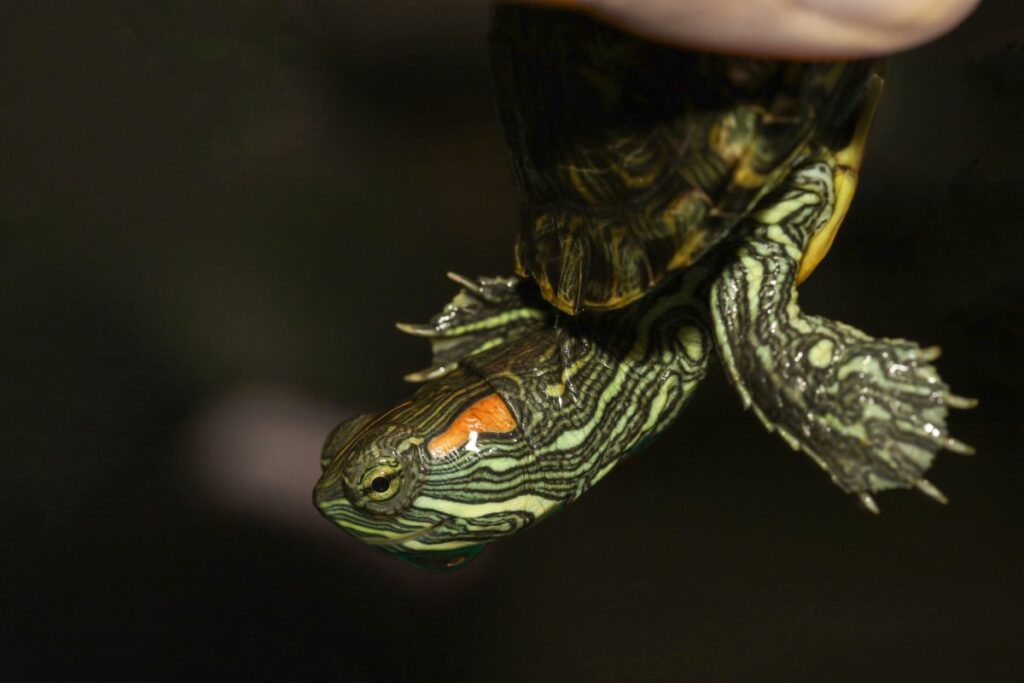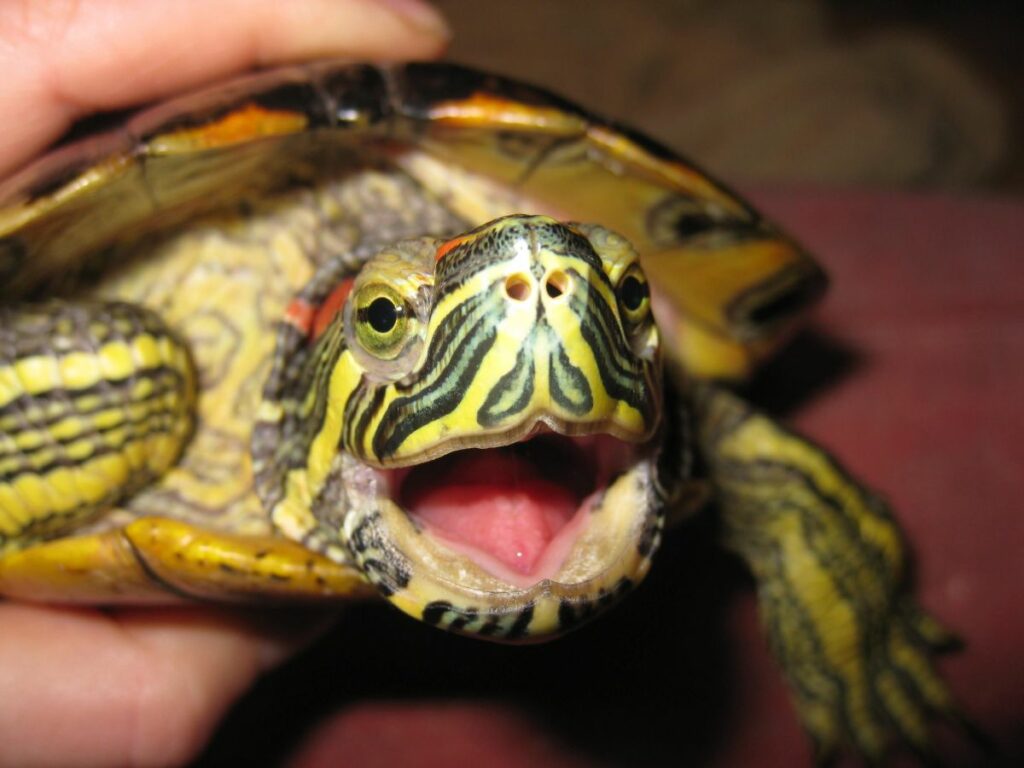Red Ear Slider care is an in-depth topic. It is also a great starting point for all potential turtle keepers because it highlights how much work goes into setting up a turtle enclosure.

Most beginner reptile keepers don’t know that aquatic turtles need more than water and a basic light. Multiple kinds of light and a constant variety of food are just as important as water quality. In this Red Ear Slider care guide I’ll touch on all of these aspects and much more, besides.
What is a Red Ear Slider?
As the most popular pet aquatic turtle in the world few people have never seen a Red Ear Slider before. They are distinctive, with a bright red stripe running along their heads that no other turtles have.
The upper shell of a Red Ear Slider is covered in green and black stripes. And the underside has delicate whorls against the yellow belly.
Red Eared Sliders are native to the United States. But the hardiness and cute character of a baby Red Eared Slider pet has led them to be imported all over the world.
And soon a few escape – or are abandoned when their owners grow bored with them. These freed turtles can establish themselves in their new home and become invasive. The Red Ear Slider is considered one of the 100 most invasive animals in the world.
As pets, however, they are one of the best turtles for beginners. Red Ear Sliders are undemanding, eat almost anything, and are sizable without being too large when full grown.
Lifespan of Red Eared Slider
An average Red Eye Slider turtle lifespan will be 20 to 30 years. Sometimes a few will live to see 40 years of age. In any case, consider buying a Red Eared Slider the start of a long-term relationship.
- Common Names: Red Eared Slider, Redneck Slider Turtle
- Scientific Name: Trachemys scripta elegans
- Origin: South and Eastern United States
- Length: 12 to 16 inches
- Aquarium Size: 40+ Gallons
- Temperament: Aggressive; Predatory
- Ease of Care: Very Easy
Red Eared Slider Care
Turtles are a little more complicated than fish to care for. But the Red Ear Slider is one of the easiest types of turtles to keep. They are well suited to beginners and live for decades.

How Big Do Red Eared Sliders Get?
Red Eared Slider max size depends on the age and sex of the animal. Like most aquatic turtles there is a big difference between the size of adult male and females. A male will be full grown by 8 to 10 inches. Females will be a couple of inches longer and sometimes as long as 16 inches.
Choosing a Red Ear Slider Tank
A spacious aquarium is the key to success in Red Ear Slider care. You want lots of water volume because turtles need room to swim. Plus they are messy animals that eat and poop in their water. A small body of water fouls much faster, meaning more maintenance for you.
Breeder-style fish tanks have a larger footprint. Since you won’t be filling your aquarium to the brim, a more spacious floor is important.
Tanks up to 55 gallons in size will work for baby Red Ear turtles. But as they grow up upgrades will be neccessary. 55 gallon tanks are 12 inches wide and will soon be too tight for a larger turtle to turn around in.
The best rule of thumb is to provide 10 gallons of space per inch of shell length. That means an adult Red Eared Slider should have 100 gallons or more to be comfortable.
Since they need so much space, Red Eared Sliders do well in outdoor ponds. And as natives to the USA they have little trouble overwintering or acclimating to summer heat.
Water Conditions and Aquascaping
Red Ear Sliders prefer a water temperature range of 70-88°F. Young turtles should always be kept warmer (no cooler than 76°F). If they are left in the cold their growth rate and metabolism is affected in a negative way. These animals need heat when young.
The best way to keep the tank heated is with a submersible heater. Choose one with care, however. Red Ear Sliders are often rough on glass heaters.
Their hard, heavy shells can crack or break a glass heater with ease. A broken heater will cause dangerous electrical failures. A heater guard is an important addition to the tank of a full grown Red Ear Slider.
Filtration is just as important. A filter that has a mature biological filtration cycle breaks down ammonia that forms from turtle poop and leftover food. But no matter how powerful your filter is, regular water changes are important to keep the water clean.
If you need further advice on setting up an enclosure, check out my more in-depth guide on Setting Up a Turtle Tank.

Red Eared Slider Lighting Needs
Light of the right spectrum is critical to the health of Red Eared Slider turtles. You will need more than just a fluorescent fixture to keep them healthy. Infrared (heat) and UV (ultraviolet) light are needed to replicate the full spectrum of the Sun.
Heat for Red Slider Turtles
Unlike aquarium fish you need to provide more than an underwater heater. A heater above the tank is also important because turtles, like all reptiles, are ectothermic. Meaning their metabolism is regulated by the temperature of the environment.
Turtles need heat to warm up and move during a cold morning. Heat also helps them digest their food, grow in a natural manner, and ensures their immune systems are working well. Heating (infrared) bulbs should be placed above the tank and are separate from visible light and UVb bulbs.
How strong of a heating bulb depends on the size of your tank and the distance from the bulb to the basking surface. Using a thermometer you want to aim for a surface temperature of 100-105°F. And an ambient air temperature of 80-90°F
Creating a UV Basking Area
Red Ear Sliders need not just heat but also ultraviolet radiation. UVb is important for proper vitamin D metabolism and immune regulation.
And without it your Redneck Slider will become sick and die. A UVb bulb should be mounted above the basking area of the tank just like the infrared basking bulb.
What Do Red Eared Sliders Eat?
Like most aquatic turtles Red Eared Sliders are omnivorous and eat both plant and animal matter. These animals need variety in their diets. A pellet or stick prepared formula is okay as a base. But fresh ingredients are important for their health.
For protein you can offer a wide range of food – even things from your own refrigerator. Fresh shrimp, pieces of fish, insects like crickets and mealworms, and earthworms are all good additions to a turtle’s diet.
You could even offer frozen baby chicks, mice, and other items as treats. Most pet stores catering to reptile keepers have these on hand.
People often offer their pet Red Belly slider feeder fish like goldfish. I don’t recommend this. Feeder fish are kept in filthy conditions. They are full of bacteria and parasites that get passed onto the animal that eats them.
Last, don’t forget the vegetables. 50% meat and 50% vegetables is best for Red Eared Slider care. Leafy greens like spinach, swiss chard, turnip greens, and lettuce will be devoured. You can even offer skinned grapes and apples as a treat, though turtles don’t have much of a taste for sweet.

Tank Mates for Red Eared Sliders
Aquatic turtles like the Red Slider don’t do well with tank mates. They will try to eat most animals they share a tank with except for other turtles. Other Red Eared Sliders will work as long as you have enough space, filtration, and basking room for all of them.
Tiny fish can sometimes escape the notice of a turtle as long as it isn’t hungry. Pond keepers may have success with a Red Ear Slider in a spacious outdoor pond with large koi or goldfish. A well fed turtle kept with much larger koi might work out.
But sometimes a turtle decides to try biting larger prey anyway. Sooner or later it will catch hold of one of your fish and leave a nasty wound. It is best to keep aquatic turtles alone if you care about the safety of your fish.
Conclusion
Red Ear Sliders are popular turtles for several good reasons. They are easy to care for and interesting to watch. These turtles also eat anything offered to them.
Just remember that the cute baby turtle you start out with won’t stay small forever. And they live for decades so be prepared to upgrade their tank once your Red Slider outgrows it.
More Frequently Asked Questions about Red Ear Sliders
Red Ear Sliders are one of the easiest turtles for new reptile owners to start out with. But maybe you have a few more questions about their care? If so then take a look at our FAQ section.
A big Red Eared Slider female can be up to 16 inches long. But 10 to 12 inches is an average size for an adult female. Male slider turtles will be around 2 inches smaller, on average.
A baby Red Ear Slider turtle will cost anywhere from $10-20, depending on the source. If you live outside of North America a baby turtle might cost more. But even in other countries the Red Ear Slider is often the least expensive and easiest to find pet turtle.
Red Ear Sliders are excellent pets as long as you can give them the space, lighting, and nutritional variety they need. Most people who fail don’t understand these principles. They provide poor quality food, not enough heat or space, dirty water conditions, or a cramped tank. Or all of the above.

